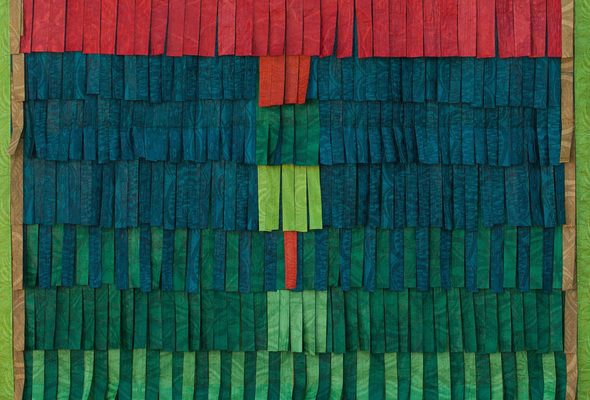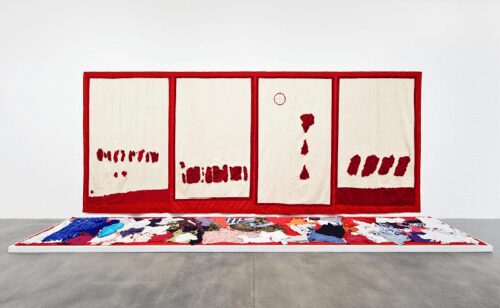Notre auteur Elsa Guily se pose son regard critique sur l'exposition USEFUL DREAMS de Abdoulaye Konaté.

Abdoulaye Konaté, Composition: No. 10 (vert) (detail) 2014 Textile 234 x 147 cm / (92⅛ x 57⅞ in). Courtesy of the artist
Entre figuration et abstraction des formes, Useful Dreams nous présente une vue d’ensemble sur l’œuvre de l’artiste Abdoulaye Konaté. L’exposition présentée à la galerie Blain|Southern (Berlin) dans son espace duplex à l’imposante verticalité, se révèle idéale pour déployer cette subtile facture de la métaphore, plastique comme thématique, évoquant la permanente tension entre expression universelle et locale dans l’art de Konaté.

Abdoulaye Konaté, Lutte contre le HIV (Fight against HIV, 1995). Textile 434x238cm. Photo: Christian Gläser, 2015 © Blain|Southern
C’est une entrée en matière plus que symbolique, que la curatrice Koyo Kouoh a choisi de mettre en scène, avec l’œuvre Lutte contre le HIV. D’une part la lourde signification du titre de cette œuvre annonce la couleur – redonner corps et matière à l’actualité par le langage artistique. Depuis ses débuts sur la scène artistique en 1991, le désir de s’exprimer de Konaté existe dans une immédiateté de réagir au paysage socio-politique malien, de combattre les violences sociales par son geste créatif, qui inscrit dans une résonnance internationale. L’art est alors un champ total, lui permettant d’exprimer l’engagement de son individualité au sein d’un corps social. D’autre part cette toile-textile brodée au grand format vertical, donne à voir la variété du langage plastique de Konaté. ‘Peintre-tissand’, il explore les rapports support/surface, formes/couleurs dans une composition all-over, pouvant s’étendre jusqu’au sol. La matérialisation de l’espace est ainsi dans cette œuvre prise à partie, formalisée par une mobilisation d’objets au pied de la toile, inscrivant le tout dans la dimension tridimensionnelle d’une installation.
Nous progressons dans l’espace d’exposition en découvrant graduellement de droite à gauche la récente série Compositions, ainsi que les séries Couples et Croix qui nous offrent un panel polychrome, emblématique des fameuses tapisserie-teinture de l’artiste. Konaté utilise le tissu comme une palette et fait du traitement de la couleur le point névralgique de sa facture. Il divulgue les rapports du nuancier de couleur et ses tonalités tout en sollicitant le camaïeu. Composées de bandelettes de coton soigneusement découpées à l’identique, Composition : No.15 et Composition : No.16 donnent à voir une subtile gestualité picturale. Perçue de manière frontale, cette accumulation et superposition de bandelettes créent un surprenant effet d’optique laissant penser qu’il s’agit là de touches de pinceau. Explorant les richesses esthétiques de la matière du tissu, ses qualités visuelles sensibles et tactiles, Konaté le travaille à la manière de la peinture. Il développe ainsi une ‘gestuelle du peindre’, déployant l’aplat à la surface en jouant avec des effets visuels conférés par les nuances de motifs des tissus wax et cotons imprimés. Sur le plan de la composition, il emploie les techniques de la couture et de la broderie pour inscrire la ligne, dessiner le trait. Cette métaphore plastique du dialogue entre peinture et dessin, visualisée par le tissu, permet par la souplesse de celui-ci un élargissement de l’horizon. L’œuvre se confond au mur, efface les indices d’accrochage, de suspension. Perçu sous un certain angle, ces compositions nous apparaîtraient presque comme des peintures murales. Appuyé par sa matière sculpturale de semi-relief ainsi que de perçants contrastes de noir et blanc, Croix de Lumière nous emmène à la découverte de l’abîme des nuances de gris. Cette exploration du format à grande échelle développe une énergie spatiale, sensible, renforcée également par le travail en série, ainsi que de jeux visuels entre détails pointilleux exploités à partir les motifs et l’ampleur du matériau.
Dans le prolongement de ce flux chromatique, c’est un face à face à l’œuvre de Konaté dans lequel nous nous engageons. Gris Gris Blanc est une vaste toile demi-relief tissée et déployée à l’horizontal du mur, à laquelle sont cousues des amulettes en tissu. Le tout est épuré par un camaïeu de beige, qui confère à cette pièce maîtresse dans l’accrochage une place centrale celui de capteur de lumière. Elle vient rééquilibrer l’espace des tonalités mis à l’épreuve par la recherche autour de la couleur. C’est une œuvre clé car elle est porteuse de l’engagement de Konaté qui tend à redonner corps et matière à l’information par le langage artistique. En effet cette œuvre est inspirée d’une tradition malienne autour du textile : la veste du chasseur sur laquelle sont accrochés des gris-gris, est un vêtement traditionnel, dont la fonction est de communiquer les exploits de ce dernier, porteur de l’histoire, de narrations des mœurs de son peuple. Un fragment de tissu de la tribu Igbo, trouvé au Nigeria et datant du IXe siècle avant Jésus Christ, nous indique que la tradition du textile est une des fondations de la culture africaine. Il est utilisé non seulement comme un objet personnel et domestique mais aussi comme un support de communication à travers les siècles. En lien avec son héritage culturel, Konaté affirme un langage visuel entre peinture et écriture, par la réappropriation des traditions, us et coutumes autour du traitement du textile.  Installation Shot II Abdoulaye Konaté. Photo: Christian Gläser, 2015 © Blain|Southern
Installation Shot II Abdoulaye Konaté. Photo: Christian Gläser, 2015 © Blain|Southern
Cette affirmation d’une écriture plastique s’étend aussi par un travail autour du signe et du symbole. Le Rouge, qui apparaît dans ses œuvres comme pointe de tension lumineuse dans la composition, intervient à la manière d’un fil conducteur de la narration, laissant varier les interprétations symboliques autour de cette couleur. Nous pouvons ainsi aisément passer à l’étage de la galerie, poursuivant la visite et faire le pont entre ses différentes œuvres malgré leur diversité formelle de l’abstraction symbolique à la figuration du signe. Le rouge est au centre de la composition de ses œuvres figuratives aux explorations sémiotiques les plus poignantes tels que Bosnie Angola Rwanda (1995), hommage aux défunts suite aux génocides qui ont traversé la fin du XXe siècle. L’intervention plastique permet ainsi de marquer les mémoires dans l’espace social et culturel. L’artiste comme témoin de l’histoire intervient dans le monde matériel, celui de l’objet, provoque une mise en situation de par la transformation plastique de celui-ci. Dans le cas présent des vêtements étalés symbolisent l’absence des corps massacrés. Il crée une situation physique de rencontre avec la thématique portée par l’œuvre, suggérant que l’identité humaine n’est pas fixe, ni statique mais bien engagée dans un flux constant de variantes d’états physiques et psychiques.

Abdoulaye Konaté, Bosnie Angola Rwanda 1995. Textile wall piece: 246 x 592 cm / (96? x 233? in) / floor piece: 100 x 592 cm / (39? x 233? in) Photo: Christian Gläser
La démarche artistique devient une façon d’être engagé auprès des hommes, de livrer un message sur les variations de la précarité de la vie et porter une critique vive sur les enjeux géopolitiques à l’heure de la mondialisation. En refusant le localisme de la pensée et l’isolation des procédés de l’information, son œuvre est destinée à circuler dans la pluralité des espaces d’expositions du globe, dans lesquels l’expérience de la perception est mise à l’épreuve par une invitation à la prise de conscience et au renouvellement des perspectives. Entre un lyrisme chromatique et la dualité des mots-titres cousus sur mesure, le langage plastique de Konaté œuvre comme parti pris d’une écriture de l’histoire, qui n’en finit pas de se (re)définir et de se (re)lire sous toutes ses coutures.
Abdoulaye Konaté, Useful Dreams, 7 février – 18 avril 2015, Blain|Southern gallery, Berlin
Elsa Guily est étudiante en histoire de l’art et critique indépendante vivant à Berlin, spécialisée dans les relations entre art et politique.
More Editorial